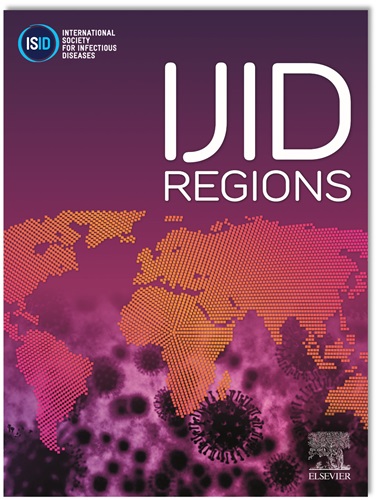Species distribution, antibiotic susceptibility and clinical characteristics in Enterococcal bacteremia; experience from South India
IF 4.8
2区 医学
Q1 INFECTIOUS DISEASES
引用次数: 0
Abstract
Introduction
While the incidence of Vancomycin-resistant Enterococci (VRE) infections in India remains lower than in other countries, recent reports indicate an upward trend. This study investigates the clinical characteristics and antibiotic susceptibility profile associated with Enterococcus bacteremia.
Methods
We conducted a retrospective analysis of patient records with Enterococcal bacteremia from January 2016 to December 2022 at our tertiary care center in Kerala, South India. For the detection of bacterial growth, BacT/AlLERT 3D instrument was used. Identification and antibiotic susceptibility were done by the VITEK-2 system.
Results
During the study period, we identified 214 unique Enterococcus isolates in blood cultures. The median age of patients was 62 years (interquartile range: 51-71 years), with males constituting 66% of the cases. The most prevalent comorbidity was diabetes, affecting 51% of patients (n=109), followed by chronic kidney disease in 27% (n=58), and chronic liver disease in 22% (n=48). Malignancies were present in 16% of patients (n=34), and 17% (n=36) experienced immunosuppression from either disease or medication. The primary sources of infection were genitourinary (17%, n=36) and intestinal (16%, n=35) tracts, with infective endocarditis (IE) observed in 7% (n=15).
E. faecalis was the predominant species, accounting for 50% of cases (n=107), followed by E. faecium at 39.5% (n=85). Other species included E. gallinarum (n=6), E. raffinose (n=4), E. durans (n=2), E. avium (n=2), and E. casseliflavus (n=1). Species identification was indeterminate in 6 isolates.
Among the E. faecalis isolates, 100% susceptibility was noted for vancomycin and linezolid, 95% for teicoplanin, 88% for penicillin, 86% for ampicillin, and 61% for gentamicin. For E. faecium, susceptibility rates were 95% for vancomycin and linezolid, 88% for teicoplanin, 36% for gentamicin, and only 11% for penicillin and ampicillin. Daptomycin was tested in 28 isolates, with 1 being resistant and 2 showing intermediate susceptibility. Among the 2 isolates that exhibited vancomycin and linezolid resistance, daptomycin remained susceptible.
Overall, 59% of patients improved, 30% expired, and 11% were discharged at their request and could not be followed up. Among the 95 patients with E. faecalis bacteremia, 67% survived, while among the 76 patients with E. faecium bacteremia, 64% survived. There was no statistically significant correlation between comorbidities, infection source, species, and clinical outcomes. Among those diagnosed with vancomycin-sensitive Enterococcus, almost one-third (29%) succumbed. Among the 4 patients diagnosed with VRE, 3 did not survive.
Conclusion
Enterococcal bacteremia is associated with significant mortality, with approximately one-third of patients succumbing to the illness. However, vancomycin resistance remains relatively low even in Enterococcus faecium isolates.
肠球菌菌血症的菌种分布、抗生素敏感性及临床特点南印度的经验
虽然印度耐万古霉素肠球菌(VRE)感染的发生率仍然低于其他国家,但最近的报告显示其呈上升趋势。本研究探讨肠球菌菌血症的临床特点和抗生素敏感性。方法回顾性分析2016年1月至2022年12月在印度南部喀拉拉邦三级保健中心的肠球菌菌血症患者记录。采用BacT/AlLERT 3D仪器检测细菌生长情况。采用VITEK-2系统进行鉴定和药敏试验。结果在研究期间,我们在血液培养中鉴定出214株独特的肠球菌。患者的中位年龄为62岁(四分位数范围:51-71岁),男性占病例的66%。最普遍的合并症是糖尿病,影响51%的患者(n=109),其次是27%的慢性肾病(n=58)和22%的慢性肝病(n=48)。16%的患者(n=34)存在恶性肿瘤,17% (n=36)因疾病或药物而出现免疫抑制。主要感染源为泌尿生殖道(17%,n=36)和肠道(16%,n=35),感染性心内膜炎(IE)占7% (n=15)。粪球菌为优势菌种,占病例总数的50% (n=107),其次是粪肠杆菌,占39.5% (n=85)。其他种属包括鸡糜泻(E. gallinarum) (n=6)、棉子糖糜泻(n=4)、杜兰糜泻(n=2)、鸟糜泻(n=2)和casseliflavus (n=1)。6株菌株种类鉴定不明确。对万古霉素和利奈唑胺的敏感性为100%,对替柯planin的敏感性为95%,对青霉素的敏感性为88%,对氨苄西林的敏感性为86%,对庆大霉素的敏感性为61%。对于粪肠杆菌,万古霉素和利奈唑胺的敏感性为95%,替柯planin的敏感性为88%,庆大霉素的敏感性为36%,青霉素和氨苄西林的敏感性仅为11%。对28株达托霉素进行了检测,1株耐药,2株中等药敏。在对万古霉素和利奈唑胺耐药的2株菌株中,对达托霉素仍敏感。总体而言,59%的患者病情好转,30%的患者死亡,11%的患者因要求出院而无法随访。95例粪肠杆菌菌血症患者生存率为67%,76例粪肠杆菌菌血症患者生存率为64%。合并症、感染源、种类和临床结果之间没有统计学上的显著相关性。在被诊断为万古霉素敏感肠球菌的患者中,近三分之一(29%)死亡。在诊断为VRE的4例患者中,3例未能存活。结论肠球菌菌血症与显著的死亡率相关,约三分之一的患者死于该病。然而,即使在粪肠球菌分离株中,万古霉素耐药性仍然相对较低。
本文章由计算机程序翻译,如有差异,请以英文原文为准。
求助全文
约1分钟内获得全文
求助全文
来源期刊
CiteScore
18.90
自引率
2.40%
发文量
1020
审稿时长
30 days
期刊介绍:
International Journal of Infectious Diseases (IJID)
Publisher: International Society for Infectious Diseases
Publication Frequency: Monthly
Type: Peer-reviewed, Open Access
Scope:
Publishes original clinical and laboratory-based research.
Reports clinical trials, reviews, and some case reports.
Focuses on epidemiology, clinical diagnosis, treatment, and control of infectious diseases.
Emphasizes diseases common in under-resourced countries.

 求助内容:
求助内容: 应助结果提醒方式:
应助结果提醒方式:


